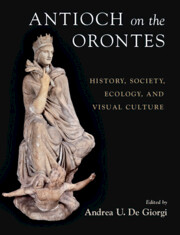Book contents
- Antioch on the Orontes
- Antioch on the Orontes
- Copyright page
- Dedication
- Contents
- Plates
- Figures
- Tables
- Contributors
- Abbreviations
- Antioch on the Orontes
- Part I Beginnings
- Part II The Making of a Capital
- Part III The People of Antioch
- Chapter 15 Women in Imperial Antioch
- Chapter 16 The Middle Classes in Fourth-Century CE Antioch
- Chapter 17 Antioch
- Chapter 18 Violence in Antioch
- Chapter 19 Antiochene Riots against Jews in Malalas’s Chronicle
- Chapter 20 Speaking of Jews
- Chapter 21 Antioch and the Political Economy of Empire in the Age of Justinian
- Part IV Religion
- Part V Crises and Resilience
- Index
- Plate Section
- References
Chapter 20 - Speaking of Jews
Late Antique Antioch’s Shifting Anti-Jewish Rhetoric
from Part III - The People of Antioch
Published online by Cambridge University Press: 06 June 2024
- Antioch on the Orontes
- Antioch on the Orontes
- Copyright page
- Dedication
- Contents
- Plates
- Figures
- Tables
- Contributors
- Abbreviations
- Antioch on the Orontes
- Part I Beginnings
- Part II The Making of a Capital
- Part III The People of Antioch
- Chapter 15 Women in Imperial Antioch
- Chapter 16 The Middle Classes in Fourth-Century CE Antioch
- Chapter 17 Antioch
- Chapter 18 Violence in Antioch
- Chapter 19 Antiochene Riots against Jews in Malalas’s Chronicle
- Chapter 20 Speaking of Jews
- Chapter 21 Antioch and the Political Economy of Empire in the Age of Justinian
- Part IV Religion
- Part V Crises and Resilience
- Index
- Plate Section
- References
Summary
Comparing the fourth-century writings of John Chrysostom and Libanius with the sixth-century writings of Severus of Antioch and John Malalas suggests that Jewish characters continued to play significant roles in Christian writings even as Jews themselves became less visible in the city of Antioch.
Keywords
- Type
- Chapter
- Information
- Antioch on the OrontesHistory, Society, Ecology, and Visual Culture, pp. 330 - 342Publisher: Cambridge University PressPrint publication year: 2024

